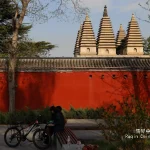Tucked away in western Beijing, Wanshou Temple (万寿寺) is often called the “Little Forbidden City of the West.” This hidden gem combines imperial grandeur with the calm, spiritual atmosphere of a centuries-old Buddhist temple.
👉Explore Our Curated Beijing Tours
Built during the Ming and Qing dynasties, it once served as a sacred place where emperors prayed for longevity and prosperity. Today, it’s also home to the Beijing Art Museum (北京藝術博物院), which houses an impressive collection of Buddhist statues, imperial calligraphy, traditional paintings, and antique Chinese furniture.
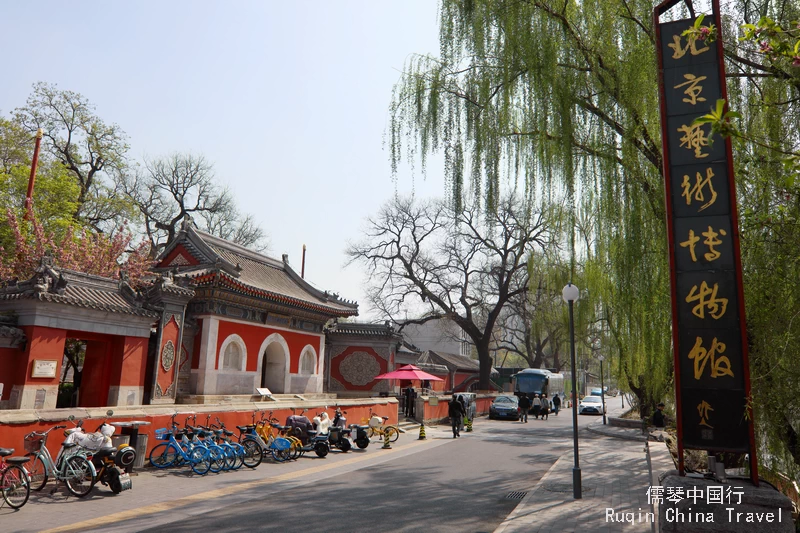
Wanshou Temple is not just a place of worship—it’s a cultural treasure trove. Its elegant architecture, tranquil courtyards, and rich history make it a perfect destination for travelers looking to connect with both Chinese royal heritage and Buddhist art.
In this guide, you’ll find everything you need to plan your visit: the temple’s history, architectural highlights, the best times to go, how to get there, suggested routes, nearby attractions, and useful travel tips to help you get the most out of your experience.
1. Wanshou Temple Steeped in Imperial History
Wanshou Temple was built in 1577 during the Ming Dynasty. The Wanli Emperor ordered its construction and gave it the name “Wanshou,” meaning “Longevity.” From the start, it served as a royal temple tied closely to the lives of emperors.
In the Qing Dynasty, emperors like Kangxi, Qianlong, and Guangxu carried out multiple renovations. The Qianlong Emperor, in particular, held three grand birthday celebrations here for his mother—turning the temple into a place of deep family devotion and imperial ritual.
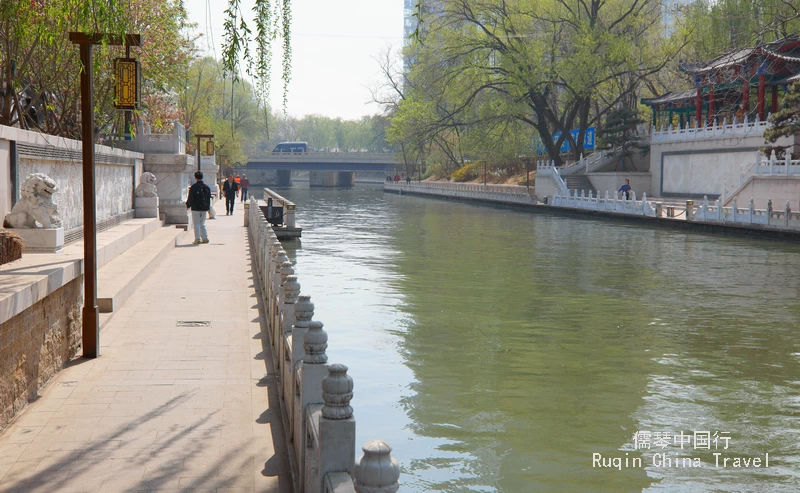
Even Empress Dowager Cixi visited often. On her way by boat along the Chang River to and from the Summer Palace, she would stop here to offer incense and rest. She favored the temple’s western courtyard palace so much that it earned the nickname “Little Ningshou Palace,” echoing the palace built for her in the Forbidden City. The Chang River is just in front of Wanshou Temple, part of the Grand Canal.
Today, Wanshou Temple is more than just a religious site. It’s a nationally protected cultural relic and home to the Beijing Art Museum. Inside the historic halls, you’ll find an incredible display of Buddhist sculptures, imperial paintings, calligraphy, and antique furniture. As you explore the temple, you’re also stepping into a living gallery of classical Chinese art and royal tradition.
2. Wanshou Temple Architectural Highlights
Wanshou Temple follows the classic symmetrical layout of traditional Chinese temples. Its structure runs along a central axis and is divided into three sections—east, central, and west. The central route is the main attraction, featuring seven courtyards in a row. Let’s walk through them step by step:
1) Shanmen (Main Gate) 山门
This is the grand entrance to the temple. The gate has three bays, a traditional hip roof, and grey tiled eaves. Above the doorway hangs a stone plaque, gifted by the Shunzhi Emperor in 1645, that reads: “Imperially Built Wanshou Temple for the Protection of the Nation.” It immediately sets the tone for the temple’s royal origins.
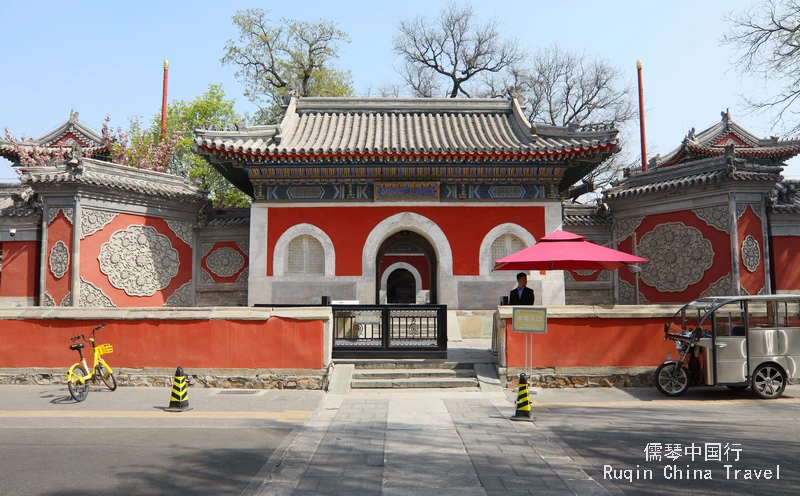
2) Bell and Drum Towers 钟鼓楼
Just behind the gate, on either side of the path leading to the Hall of Heavenly Kings, stand the Bell and Drum Towers. These towers have double-eaved hip roofs and once housed the famous Yongle Bell, now moved to Juesheng Temple. They added rhythm and ritual to the temple’s daily life.
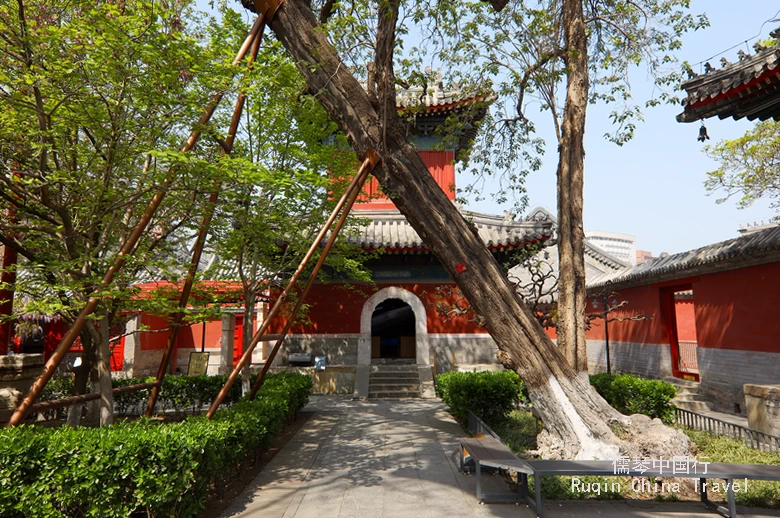
3) Hall of Heavenly Kings (Tianwang Hall) 天王殿
This hall once housed statues of the Four Heavenly Kings, guardians of Buddhist law. It also included statues of Maitreya and other protector deities—though these have since been removed.
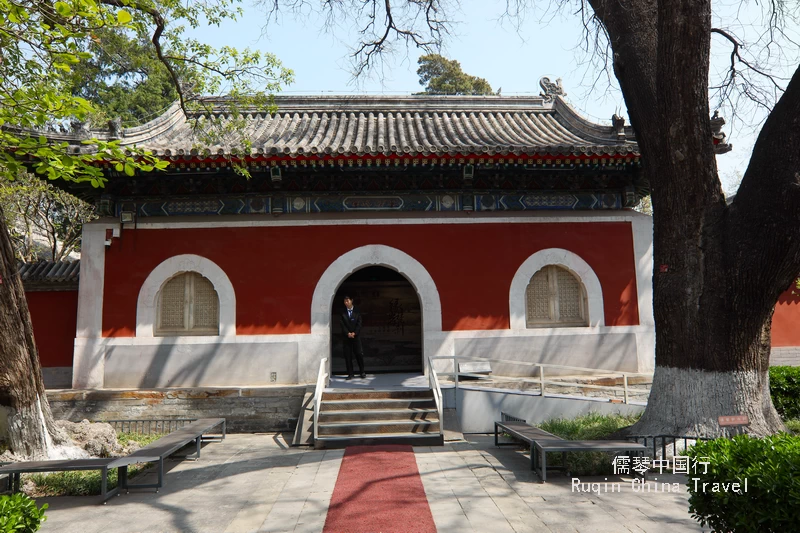
Today, the hall serves as a small exhibition space. Through text and images, it tells the story of Wanshou Temple’s journey—spanning the Ming Dynasty, Qing Dynasty, Republic era, and modern times.

4) Main Hall (Mahavira Hall / Dayanshou Hall) 大雄宝殿(大延寿殿)
This is the heart of the temple. Originally called Dayanshou Hall, it was later renamed Huiri Changhui Hall, after the plaque written by Emperor Yongzheng that now hangs at the front.
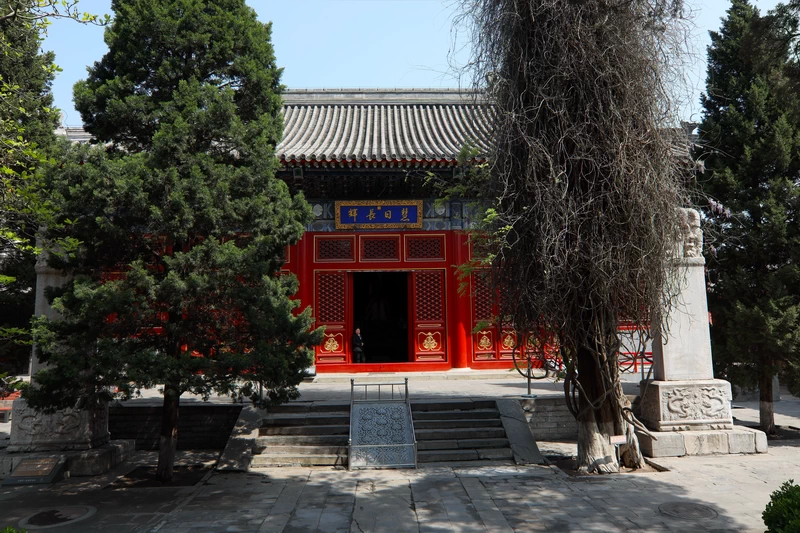
The hall features five bays, a grand hip-and-gable roof with yellow glazed tiles, colorful beams, and elegant brackets. Inside, it houses statues of Vairocana and the Three Buddhas of the Past, Present, and Future.

On either side are two smaller halls. The eastern one, Zhuyan Wanshou, focuses on Han Chinese Buddhism. The western one, Anxin Jing, features Tibetan Buddhism, including rare tantric statues and religious artifacts.
5) Wanshou Pavilion (Wanshou Ge) 万寿阁
Also called Ning’an Pavilion, this was once a royal space for prayer. It has seven bays and elegant tile roofing. The east and west annexes—Weituo Hall and Damo Hall—complete the space.
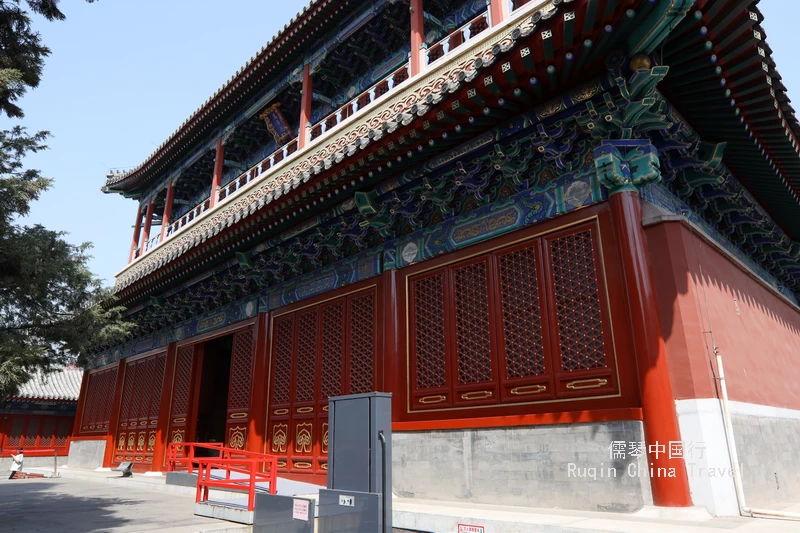
Today, it displays an excellent collection of Ming and Qing dynasty Buddhist artifacts, including jade carvings and porcelain.
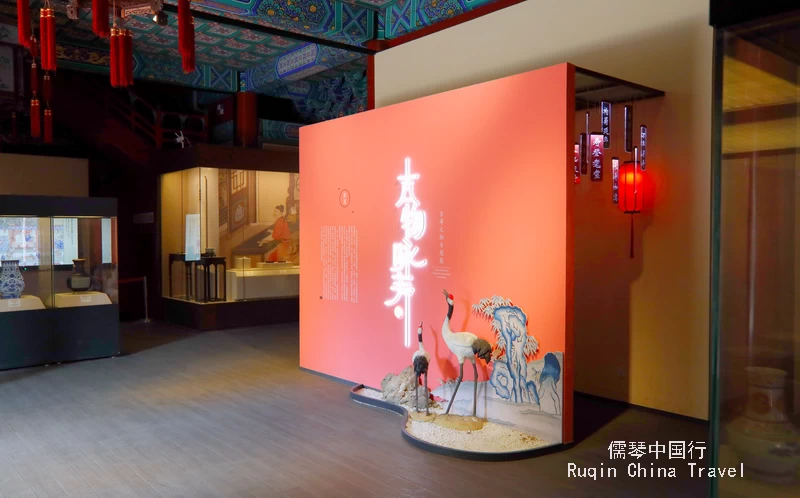
6) Grand Meditation Hall (Da Chantang) 大禅堂
This quiet space once served as a place for monks to chant and meditate. The main hall has five bays and a gabled roof. Smaller side halls were used for seated meditation.
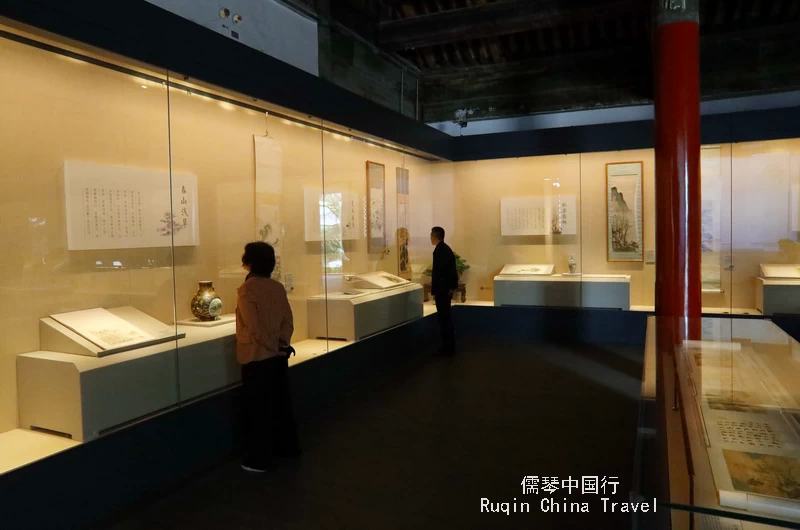
Now, the hall showcases traditional landscape paintings from the Ming and Qing periods, perfect for art lovers.
7) Imperial Stele Pavilion (Yubei Ting) 御碑亭
This octagonal pavilion features a double-eaved roof with bright yellow tiles. Inside, you’ll find a stele inscribed by Emperor Qianlong, commemorating the temple’s renovation.

The text appears in four languages—Chinese, Manchu, Mongolian, and Tibetan—showing the multicultural influence of the Qing court.
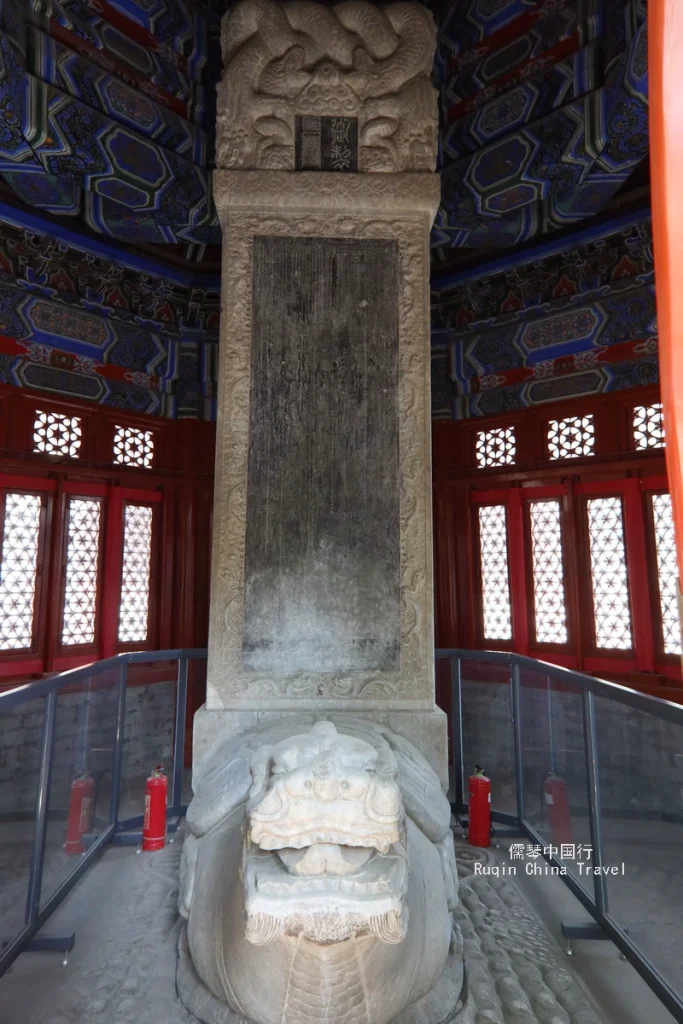
8) Amitabha Hall (Wuliangshou Buddha Hall) 无量寿佛殿
This hall honors Amitabha, the Buddha of Infinite Life. It symbolizes long life and the Western Pure Land. Built in 1761, the hall has a single bay, a double-eaved roof, and classic grey tiles.
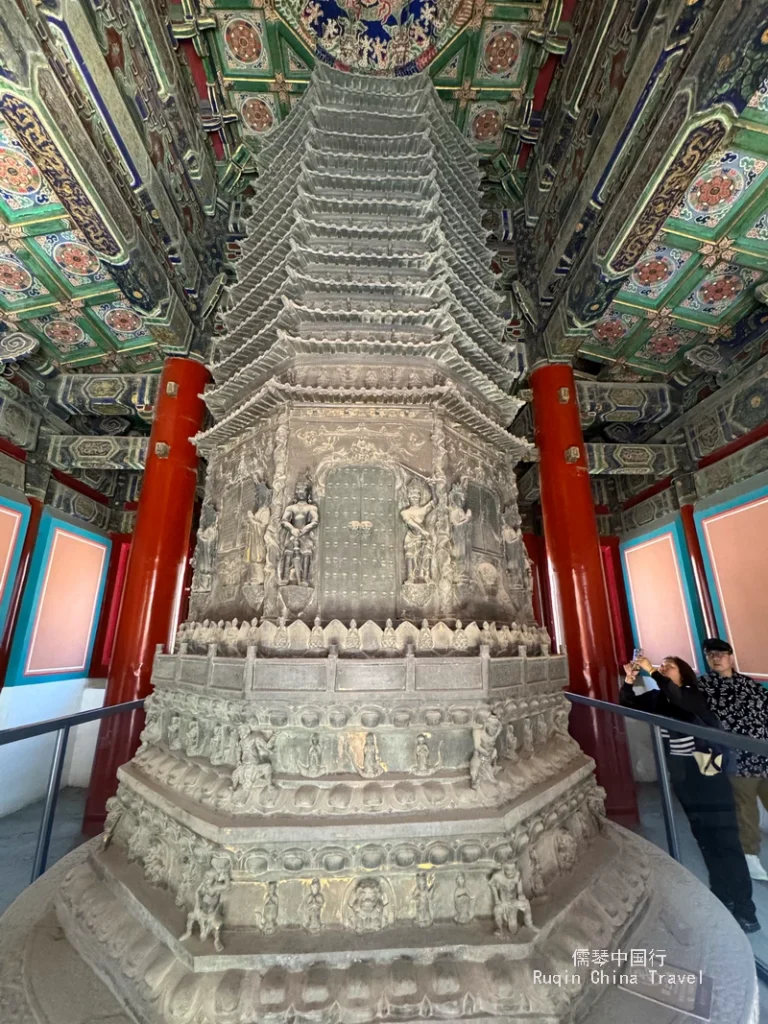
But what truly stands out are the two Baroque-style gates (两座巴洛克式门) on either side. These “Western-style doors” blend Chinese and European design. It’s said Emperor Qianlong personally ordered these elements from the Old Summer Palace (Yuanmingyuan) to be recreated here, adding a unique flair to the temple’s royal architecture.
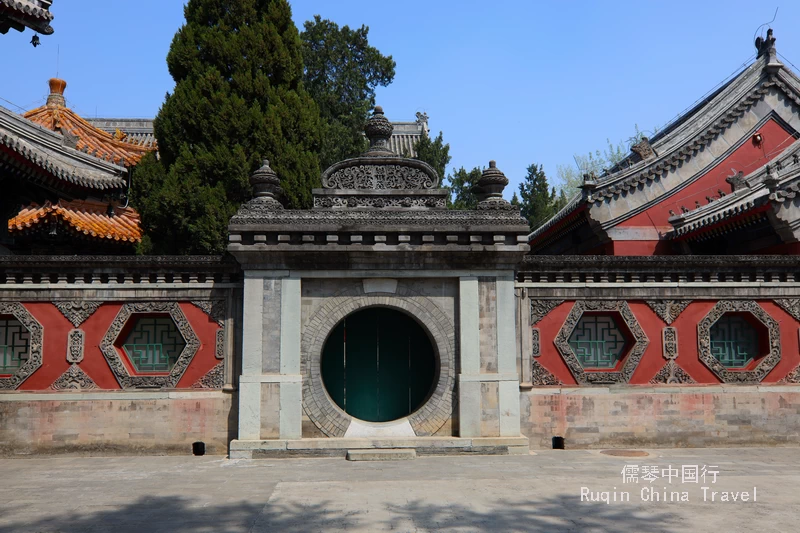
8. Abbot’s Courtyard (Fangzhang Yuan) 方丈院
Located along the eastern route of the temple, the Abbot’s Courtyard offers a quieter, more understated space. Traditionally, this was where monks lived and carried out their daily routines. The courtyard reflects simplicity and calm—true to the spirit of monastic life.

It includes dormitories, a dining hall, and meeting rooms. These were all essential for the monks’ daily life and spiritual practice.

Today, the courtyard houses part of the Beijing Art Museum collection. Inside, you’ll find furniture from the Ming, Qing, and Republic periods on display. What makes it special is that there are no newly built museum halls at Wanshou Temple. Instead, the temple’s historic buildings are carefully adapted as exhibition spaces—allowing visitors to experience these artifacts in a truly authentic setting.
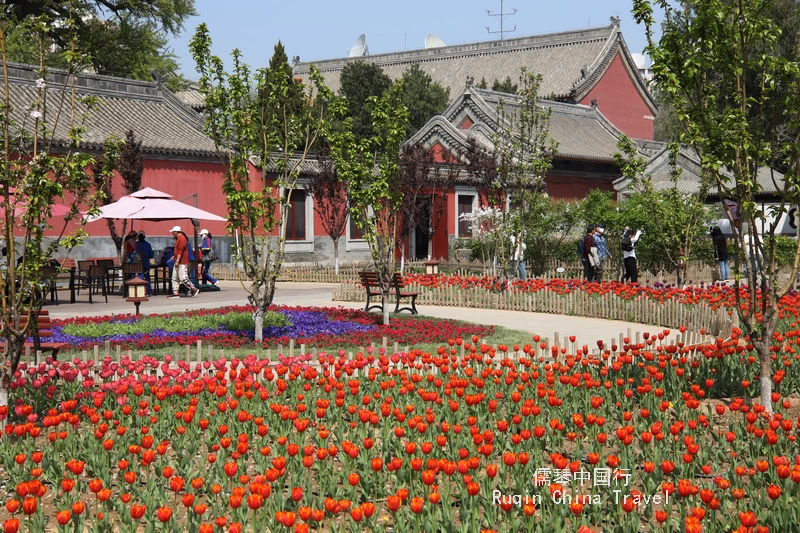
Just in front of the courtyard, there’s now an open space planted with tulips of various kinds. When I visited in mid-April, they were in full bloom—a stunning surprise that added a splash of spring color to the historic setting. It’s a perfect spot to pause, take in the scent of flowers, and snap a few photos.
9) Don’t Miss: The Ancient Ginkgo Trees
Scattered across the temple grounds are several 300-year-old ginkgo trees. In autumn and winter, their golden leaves light up the courtyards with breathtaking color. It’s a favorite photo spot for locals and tourists alike—especially those who love capturing tranquil, timeless scenes.
3. Best Time to Visit Wanshou Temple
You can visit Wanshou Temple any time of year. Each season offers a different experience.
- Spring (March–May): The temple comes alive with blooming flowers and lush greenery. It’s the perfect time to enjoy the peaceful, Zen-like atmosphere.
- Summer (June–August): The grounds are shaded by tall trees, offering a cool retreat. However, bring a hat and sunscreen—it can get hot.
- Autumn (September–November): This is the most beautiful season. The ancient ginkgo trees turn a brilliant golden yellow, creating postcard-perfect views.
- Winter (December–February): Fewer visitors come in winter. The quieter setting lets you truly soak in the temple’s solemn and sacred vibe.
4. How to Get to Wanshou Temple
Wanshou Temple is located at No. 121 Wanshou Temple Road, on the west side of Guangyuan Sluice by the Gaoliang River (also called Chang River), in Haidian District, Beijing. It’s very easy to reach.
👉Explore Our Curated Beijing Tours
By Public Transportation
- Subway:
Take Line 16 to Wanshou Temple Station. Use Exit C, then walk about 5 minutes to the temple gate. - Bus:
You can also take several bus lines, including 74, 300, 323, 362, 374, 482, 634, or Special Line 8. Get off at Wanshou Temple Station, and you’re just a short walk away.
By Car or Taxi
You can navigate to “Beijing Wanshou Temple” or “Beijing Art Museum” in your GPS. There is a parking lot nearby, but spaces are limited. To avoid hassle, it’s best to arrive early or take public transport.
5. Empress Dowager Cixi’s “Imperial Waterway”: A Royal Journey Along the Chang River
Hidden behind the red walls of the Forbidden City, Empress Dowager Cixi often found herself weary of bumpy carriage rides. In the heat of summer, she much preferred a graceful boat ride along the Chang River, drifting westward toward the cool breezes of the Summer Palace.
This river, also known as the Imperial River, was no ordinary waterway. For centuries—through the Yuan, Ming, and Qing dynasties—it served as a royal water route, linking the heart of Beijing to its western outskirts. Along this journey, Wanshou Temple stood as a sacred stop: part temple, part imperial rest house.
A Royal Pause at Wanshou Temple
As Cixi’s ornate barge approached the Guangyuan Sluice, the waters calmed. This ancient stone sluice, built during the Yuan Dynasty, acted as a gateway from the Grand Canal into the capital. When the imperial boat reached the sluice, workers would kneel in greeting and carefully adjust the water level—raising or lowering the boat like a stage curtain before the next act.
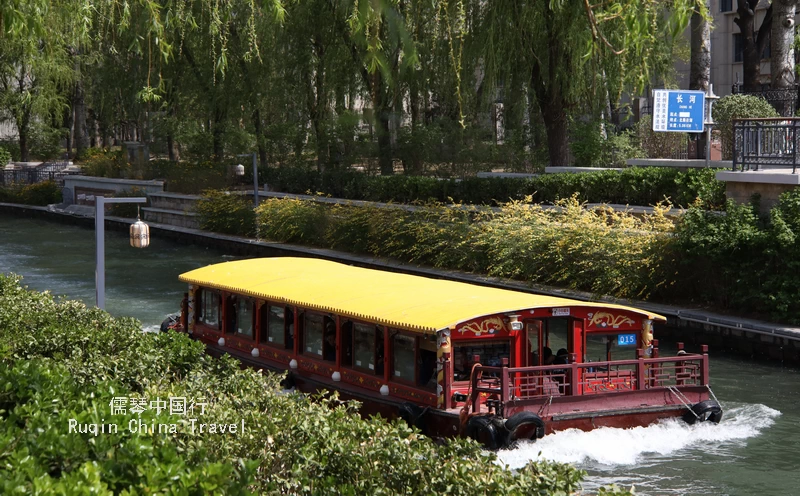
Soon, the gilded rooftops of Wanshou Temple came into view. Bells rang. Drums sounded. Monks lined up, bowing in deep reverence as the Empress stepped ashore. Holding onto a young eunuch’s arm, she walked along the smooth imperial stone path into the western wing of the temple complex—her “water palace” for the day.
Here, under ancient cypress trees and surrounded by polished rosewood furniture and cloisonné incense burners, she would rest, sip tea, and offer incense in the Mahavira Hall. Inside, the statues of the Three Buddhas stood calm and smiling. In silence, she placed precious sinking incense from Jiangnan at the altar. The smoke curled upward, perhaps carrying with it her whispered wish: “Wanshou Wujiang” (may longevity be endless).
The Legacy of the Imperial Waterway
The Chang River, or “Yuhe” (Imperial River), was originally built by the famous Yuan dynasty engineer Guo Shoujing. It formed the final stretch of the Grand Canal, connecting Jishuitan in central Beijing all the way to the Summer Palace.

Even today, you can visit the Guangyuan Sluice, still standing quietly beside Wanshou Temple. Nearby, the Dragon King Temple preserves stone inscriptions from the Ming and Qing eras, chronicling stories of water control and royal travel.
A Journey You Can Still Take
The very route Cixi once traveled is now part of the “Changhe Willow Boat Tour”—a public cruise line that lets visitors retrace a small piece of this historic journey. Floating down the same waterway, you can imagine the sights, sounds, and imperial elegance of a time when boats carried queens to prayer, and temples welcomed royalty by river.
6. Nearby Attractions Worth Exploring
Wanshou Temple is located in Beijing’s western suburbs—a peaceful area full of cultural gems and natural beauty. If you have extra time, here are some great places nearby to explore:
🎋 Zizhuyuan Park (Purple Bamboo Park) – 10-minute walk
Looking for a quiet break surrounded by nature? Head to Zizhuyuan Park, famous for its lush bamboo groves and charming lakeside paths. This park offers a calm, leafy escape from the city’s hustle. It’s perfect for a relaxing walk, reading on a bench, or enjoying a picnic in spring or summer.
🐼 Beijing Zoo – 2 subway stops away
Hop on Line 16 for just two stops, and you’ll reach Beijing Zoo (Beijing Panda House)—one of the oldest and largest zoos in China. It’s especially famous for its giant pandas, but you’ll also find a wide variety of animals from China and around the world. Families and animal lovers will enjoy spending a couple of hours here.
🪨 Five-Pagoda Temple (Beijing Stone Carving Art Museum) – Just north of the North Gate to Beijing Zoo
Just a short stroll from Beijing Zoo ( Beijing Panda House ), Beijing Five Pagoda Temple is best known for its stunning Vajra Throne Pagoda, or Jingang Baozuo Ta. The temple houses the Beijing Stone Carving Art Museum, which features exquisite Buddhist reliefs, ancient steles, and stone sculptures. Many visitors call it one of the most architecturally unique Buddhist temples in Beijing. If you love intricate design and peaceful courtyards, don’t miss this spot.
🏞 Summer Palace – About 15 minutes by subway
One of Beijing’s most iconic landmarks, the Summer Palace is a UNESCO World Heritage Site and the crown jewel of Chinese imperial gardens. Wander along Kunming Lake, climb Longevity Hill, and marvel at the painted corridors and palaces. It’s only about 15 minutes away by subway and well worth the detour.
🍁 Fragrant Hills Park (Xiangshan Park) – Especially stunning in autumn
If you’re visiting in the fall, make time for Fragrant Hills Park. Located a bit further west, this park is famous for its fiery red maple leaves. The colors peak in late October, making it one of the best places in Beijing for autumn foliage. The park also offers great hiking trails and panoramic city views.
👉Explore Our Curated Beijing Tours
Wanshou Temple may not appear on every tourist map—but that’s exactly what makes it special.
Here, you can step into a quieter side of Beijing’s imperial past. You’ll wander through serene courtyards, admire rare Buddhist art, and breathe in the peaceful charm of centuries-old ginkgo trees. Whether you’re a history buff, art lover, or curious traveler, this temple offers a rare blend of cultural depth, architectural beauty, and hidden royal stories.
Pair it with nearby gems like the Five-Pagoda Temple or a boat ride along the Chang River, and you’ve got a perfect half-day escape from the city’s crowds.
So next time you’re in Beijing, leave a little space in your schedule—and discover the “Little Forbidden City of the West.”

